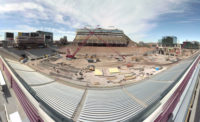
A little more than 55 years after it was originally constructed — and more than five years since the renovations were deemed necessary — Arizona State University announced on Thursday that Hunt Construction and Sundt Construction, Inc. will be the construction manager at-risk for the project.
The university also announced that Arizona-based Gould Evans and national stadium design experts HNTB Corporation will handle design duties. Costs and details will be refined over the next year and construction is slated to begin in January 2015.
Bruce Jensen, the university’s executive director for capital programs, said cost and time savings advantages nudged ASU to use the construction manager at-risk method for the stadium project.
”We have taken an approach that maximizes cooperation and collaboration,” said Jensen. “The success of this project, in large part, requires an architect and a construction manager who will work together, designing as we go forward. We have that in place and the next round of work starts today.”
In selecting Hunt, Sundt, Gould Evans and HNTB, used a request for qualifications process to solicit proposals and then conducted interviews with finalists.
“Sun Devil Stadium is an iconic venue that represents Arizona’s sports history and will be the exemplar for its future,” said Hunt’s Executive Vice President Robert Hart. “Hunt Construction is thrilled to be a part of it, as we have been to other defining local projects. This project is a commitment by the university to our community, and our firm makes the same commitment to ASU to help create a landmark that makes us all proud.”
ASU says it is seeking a final result that focuses on sustainability, technology and innovation. Some of the enhancements are expected to include an expanded student section, a new concourse experience, better seating, more restrooms with enhanced quality, improved concessions, a premiere video board and sound system, in-stadium technology for fan enjoyment and education, extensive accessibility improvements, an air-conditioned club, and other amenities.
In 2007, ASU revealed that engineers determined the structural steel supporting the stadium was rusting, causing the concrete to buckle. The university said the rusting was due to original construction and design parameters failing to include weatherproofing of the steel. Extensive washing of the facility allowed water exposure that was not expected. Repair of the structure was estimated at $45 million.
In 2012, a $300 million renovation was announced and later scrapped. Last October, work began on the removal of 5,700 seats on the north end zone.
“Arizona State University is setting benchmarks for innovation, excellence and sustainability and we are honored to be a part of this important project. Football stadiums are part of the collegiate experience and we look forward to playing a role in helping people see what a world-class university does with its public venues”, said Gerardo Prado, a principal with HNTB.


Post a comment to this article
Report Abusive Comment